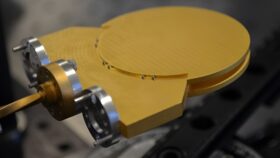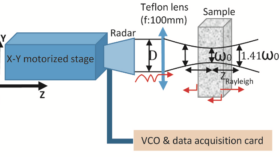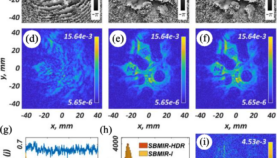
Skeletonization and 3D rendering with real time terahertz tomography
In this collaborative article between Lytid, IMS and Noctylio, we explore the application of terahertz (THz) technology in tomography to create 3D reconstructions in real time.
The experimental setup is based on a latest generation micro-bolometric camera with 240×320 pixels, equipped with an anti-reflective coated lens developed by Lytid, to record the projection images of the samples. A simple recording scheme, supplemented by an illumination source and beam shaping elements, uses Lytid’s Teracascade 2000 QCL source, providing a 5 mW illumination beam at 2.5 THz. To overcome the limitations due to highly contrasting interference patterns, solutions such as the use of oscillating mirrors or galvanometric beam steering to homogenize the illumination are discussed.

sinogram relative to a medial height recording plane, (c) photograph of the sample, a triple
tree leaf (a pixel is 200 µm size)
In this work, we address issues related to interference patterns and propose solutions to improve beam homogenization and imaging system versatility for real-time applications. This work highlights the importance of overcoming coherent optical limitations to improve tomographic reconstruction and imaging capabilities. This article also details how this technology can be used for 3D volumetric reconstruction and inspection of internal structures of transparent objects using terahertz computed tomography (THz CT). It highlights the adaptability of this approach for a variety of dielectric materials and its usefulness in non-destructive contexts.

This study concludes on the effectiveness of THz technology in 3D reconstructions and discusses future potentialities, particularly in terms of improving segmentation, component labeling and skeletonization to provide a more detailed and informative analysis of the morphology of the samples.
This work presents a significant advance in the field of terahertz imaging, demonstrating the application possibilities of this technology in areas such as quality control, biomedical research, and preservation of cultural heritage.
Adrien Chopard, Jean-Paul Guillet, Pierre Gellie, Benoit Recur, Hugo Balacey, and Patrick Mounaix, “Skeletonization and 3D rendering with real time terahertz tomography,” Opt. Continuum 2, 1060-1067 (2023)


